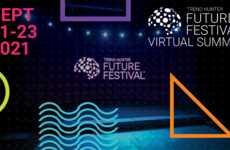Microgenerations and Consumer Behavior Post-Covid
Armida Ascano — September 11, 2021 — About
At its core, generational segmentation is about understanding a group's shared experiences and how they impact their current stage of life; consumer behavior post-covid is more complex. For example, the shared experience of the pandemic belongs to no group in particular; it has affected everyone. However, it has influenced specific generational groups in ways that question our pre-conceived notion of generational behavior -- Baby Boomers have greatly increased their social media use; Millennials are moving out of metropolitan areas -- all because people's priorities shift in times of volatility.
As the Chief Content Officer and head Futurist at Trend Hunter, I approach generational segmentation by breaking the four most well-known generations -- Baby Boomers, Generation X, Millennials, and Generation Z -- into 9 Microgenerations to better speak to each group's nuances. These nuances are the key to understanding where a particular generation's priorities will fall post-pandemic. For instance, older members of Generation Z are entering the first stages of adulthood in this "new normal." However, younger members of Generation Z will not remember the world pre-covid; this "new normal" will be their "normal."
As consumer behavior post-covid shifts quickly and drastically, how will your brand stay relevant?
I answer this question in my Future Festival Microgenerations keynote by comparing each generation's motivations and behaviors pre-pandemic to where they are today, highlighting Insights and case studies along the way. These include:
Gen Z Creative: Generation Z is forgoing, or adding to their traditional education by engaging in more creativity-focused training.
Mutual Aid Network: The generation of "hashtag activism" takes their support off the Internet and into the real world, often without the assistance of brands or organizations.
Personalized Sharing: Millennials are rebelling against the toxic "culture of comparison" brought on by the rise of the influencer by opting for more authenticity online.
Familial Workplace: As many generations work from home, older Millennials and members of Generation X who did so alongside children learning from home realize the benefits of a family-centric workspace -- online, or offline.
Intergenerational Tech: To battle isolation, Baby Boomers seek ways to better connect with their family members virtually, increasing their comfort levels in the digital space.
These examples scratch the surface of what I'll be diving into at Future Festival Virtual. The Microgenerations presentation, alongside our trend keynotes on such pivotal topics as retail reinvention, work culture, and social media, are on Day 2, so remember to upgrade to that PRO ticket if you haven't. Additionally, we offer custom versions of our trend keynotes, as well as custom research to help you dive deeper into your target demographic.
How do you nurture an understanding of a generational segment when their priorities are shifting in real-time?
As the Chief Content Officer and head Futurist at Trend Hunter, I approach generational segmentation by breaking the four most well-known generations -- Baby Boomers, Generation X, Millennials, and Generation Z -- into 9 Microgenerations to better speak to each group's nuances. These nuances are the key to understanding where a particular generation's priorities will fall post-pandemic. For instance, older members of Generation Z are entering the first stages of adulthood in this "new normal." However, younger members of Generation Z will not remember the world pre-covid; this "new normal" will be their "normal."
As consumer behavior post-covid shifts quickly and drastically, how will your brand stay relevant?
I answer this question in my Future Festival Microgenerations keynote by comparing each generation's motivations and behaviors pre-pandemic to where they are today, highlighting Insights and case studies along the way. These include:
Gen Z Creative: Generation Z is forgoing, or adding to their traditional education by engaging in more creativity-focused training.
Mutual Aid Network: The generation of "hashtag activism" takes their support off the Internet and into the real world, often without the assistance of brands or organizations.
Personalized Sharing: Millennials are rebelling against the toxic "culture of comparison" brought on by the rise of the influencer by opting for more authenticity online.
Familial Workplace: As many generations work from home, older Millennials and members of Generation X who did so alongside children learning from home realize the benefits of a family-centric workspace -- online, or offline.
Intergenerational Tech: To battle isolation, Baby Boomers seek ways to better connect with their family members virtually, increasing their comfort levels in the digital space.
These examples scratch the surface of what I'll be diving into at Future Festival Virtual. The Microgenerations presentation, alongside our trend keynotes on such pivotal topics as retail reinvention, work culture, and social media, are on Day 2, so remember to upgrade to that PRO ticket if you haven't. Additionally, we offer custom versions of our trend keynotes, as well as custom research to help you dive deeper into your target demographic.
How do you nurture an understanding of a generational segment when their priorities are shifting in real-time?
Trend Themes
1. Microgeneration Segmentation - There is an opportunity for businesses to understand and cater to the nuances of each microgeneration's shifting priorities post-pandemic.
2. Creativity-focused Training - Gen Z's engagement in creativity-focused training presents an opportunity for businesses to provide innovative education alternatives.
3. Authenticity Online - The rebellion against the 'culture of comparison' by Millennials presents an opportunity for businesses to promote more authentic content online.
Industry Implications
1. Education - Businesses in the education industry can capitalize on the trend of creativity-focused training for Gen Z.
2. Social Activism - The mutual aid network trend presents a disruptive innovation opportunity for social activism organizations to improve off-internet support.
3. Digital Communication - The intergenerational tech trend presents an opportunity for businesses in the digital communication industry to cater to Baby Boomers' need for virtual connection.
6.4
Score
Popularity
Activity
Freshness






















